Karl Shuker's Blog, page 54
May 30, 2013
A SURPRISE OF SERVICALS
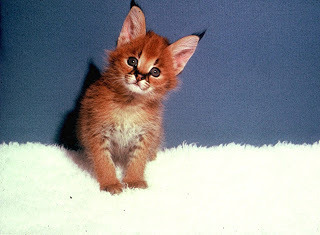 A delightfully cute servical (serval x caracal hybrid) kitten (Dr Warren D. Thomas)
A delightfully cute servical (serval x caracal hybrid) kitten (Dr Warren D. Thomas)Many different hybrids between the smaller species of wild cat have been recorded over the years, but I would like to mention one particular interspecific (indeed, intergeneric) cross featuring smaller cats here - because, as far as I am aware, when I originally included details of it in the article of mine (Wild About Animals, February 1996) on which this ShukerNature blog post is based, it was the first time that a successful mating between these two species had ever been documented.
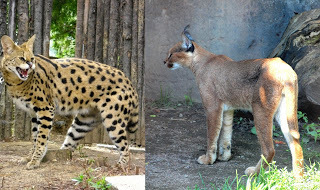 A serval, left; and a caracal, right (both public domain)
A serval, left; and a caracal, right (both public domain)In 1993, Dr Warren D. Thomas informed me that a few years earlier, while he was director there, a litter of four feline hybrids was born at Los Angeles Zoo, sired by a serval Leptailurus serval and born to a caracal Caracal caracal. This very unusual mating took place quite by accident, while the two cats were participating in an educational programme.
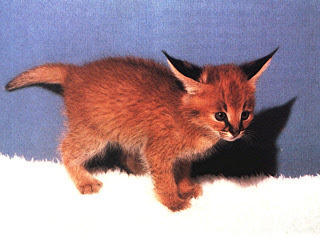 Servical kittens have BIG ears! (Dr Warren D. Thomas)
Servical kittens have BIG ears! (Dr Warren D. Thomas)Two of the four cubs died in the first 10 days after their birth; the other two survived, but at the age of 8 months they were given away to a local animal sanctuary. As cubs, these 'servicals' resembled sandy-brown balls of fur, with two enormously broad ears like those of their serval father yet bearing distinctive tufts at their tips like their caracal mother's. When adult, they would probably have been fox-sized, bearing in mind the adult size of servals and caracals.
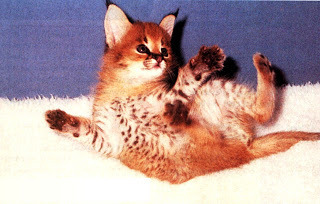 A playful servical kitten (Dr Warren D. Thomas)
A playful servical kitten (Dr Warren D. Thomas)Since then, the reverse cross, between a male caracal and a female serval, has also been recorded with captive specimens. The resulting hybrids are known as caravals.
Providing further evidence that the serval is not as reproductively isolated from other cats as was once thought, a new ‘domestic’ breed of cat has been developed by crossing the serval with domestic cats F. catus. The result of this unexpected hybridisation is a very eyecatching breed termed the savannah, which is now popular in the USA. As might be expected from such a cross, the savannah is a very sizeable animal. One such specimen, a female called Mecca, was 18 in tall when sitting. Similarly, a male called Harley, kept as a pet in America during the late 1990s, weighed over 20 lb when only 9 months old, and could leap over a decent-sized settee in a single bound.
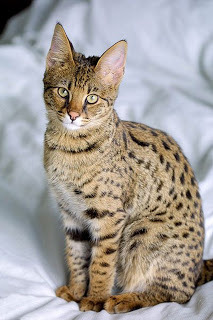 A savannah cat (public domain)
A savannah cat (public domain)Savannahs look very like servals, sporting their characteristic pelage of blotches and polka dots, but are said to be very affectionate pets, playing with normal domestic kittens, enjoying human company, and purring like a normal domestic cat. This ShukerNature blog is excerpted from my book Cats of Magic, Mythology, and Mystery: A Feline Phantasmagoria (CFZ Press: Bideford, 2012).
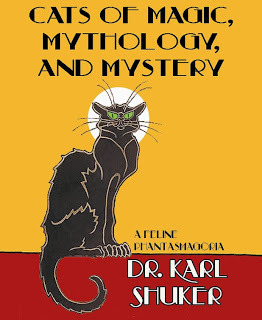
Published on May 30, 2013 18:29
May 21, 2013
A HITHERTO-UNSEEN PHOTOGRAPH OF RANGER - SCOTLAND'S (NEARLY) BLACK LION
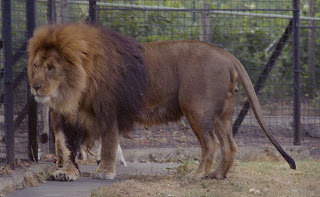 Ranger as an adult lion at Glasgow Zoo, cropped version (Peter Adamson)
Ranger as an adult lion at Glasgow Zoo, cropped version (Peter Adamson)With almost 900,000 hits since I uploaded it on 12 June 2012, by far the most popular of all of my 300+ ShukerNature posts is my exposure of three online black lion photographs as computer-modified fakes (click here ). In that same post, I also included some information concerning various alleged sightings in the wild of genuine black lions, plus a very interesting lion cub called Ranger, born at Glasgow (formerly Calderpark) Zoo in Scotland during 1975.
What made Ranger so interesting is that he possessed a black chest and a large patch of black pigment on one leg, possibly the result of a rare pigmentation phenomenon known as mozaicism. I learnt from the zoo's then director, the late Richard O'Grady, that in an attempt to create an entirely black lion, Ranger was mated with his mother, Kara, on several occasions when he reached adulthood, and also with other lionesses, but no offspring ever resulted. Consequently, it was suspected that Ranger was sterile, though he was in excellent overall health and lived to the ripe old age of 22.
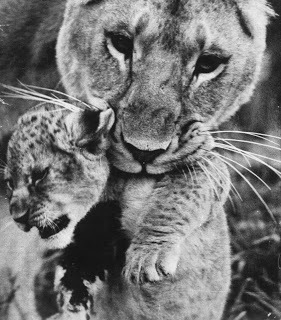 Ranger and his mother Kara (Richard O'Grady/Zoological Society of Glasgow & West of Scotland)
Ranger and his mother Kara (Richard O'Grady/Zoological Society of Glasgow & West of Scotland)Until very recently, the only photo of Ranger that I had ever seen was the above b/w photograph, which was kindly supplied to me by Richard O'Grady back in the late 1980s for use in my writings. It depicts Ranger as a cub held by Kara, and clearly reveals his black chest and the large patch of black pigment on his right foreleg.
On 28 March 2013, however, I received a short email from Mr Peter Adamson of St Andrews, Scotland, who, to my great excitement, not only mentioned that on 28 July 1984 he had seen Ranger as an adult lion at Glasgow Zoo but also attached with his email a colour photograph that he had snapped of him there, showing Ranger to have matured into a very impressive individual with a handsome black-tipped mane.
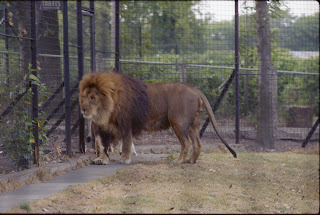 Ranger as an adult lion at Glasgow Zoo, uncropped version (Peter Adamson)
Ranger as an adult lion at Glasgow Zoo, uncropped version (Peter Adamson)Reproduced here by kind permission of Peter, it clearly displays the patch of black pigment on Ranger's right foreleg, and, as pointed out by Peter in his email to me, it also reveals that he possessed another large, though slightly paler patch of black pigment on the rear upper portion of his left hind leg, which I hadn't previously known about, and which provides further support for the prospect that Ranger was exhibiting mozaicism.
My grateful thanks once again to Peter Adamson for bringing to my attention his extremely interesting yet hitherto-unpublished colour photograph of the adult Ranger, and for very generously allowing me to document it publicly for the first time - yet another ShukerNature exclusive!
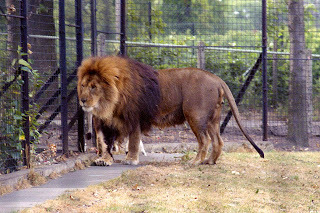 Ranger as an adult lion at Glasgow Zoo, with increased contrast (Peter Adamson)
Ranger as an adult lion at Glasgow Zoo, with increased contrast (Peter Adamson)For more information concerning black lions and other melanistic mystery cats, check out my latest book, Cats of Magic, Mythology, and Mystery: A Feline Phantasmagoria (CFZ Press: Bideford, 2012).
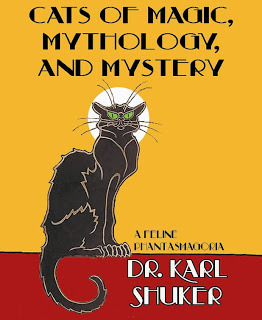
Published on May 21, 2013 14:31
May 11, 2013
A KINTAIL KAPYBARA?? - I DON'T THINK SO!!
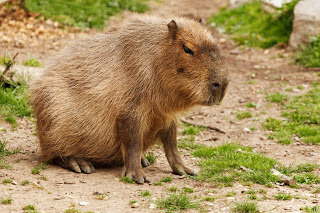 A capybara Hydrochoerus hydrochaeris (public domain)
A capybara Hydrochoerus hydrochaeris (public domain)Things are rarely what they seem in cryptozoology, as epitomised by the following case investigated by me.
Reading through some correspondence tonight reminded me of the time when I received an interesting letter from one longstanding correspondent, Miss Lorna Lloyd of Worcester, England, describing the head of a strange animal mounted as a trophy on a shield, and seen in an antique shop in London's famous Portobello Road. My correspondent likened the head to that of a gigantic guinea pig with greyish rabbit-like colouring, mentioned that the shield was engraved "Kintail 1894" , and stated that Kintail is one of the wilder areas of Inverness-shire. What could this creature possibly be?
Needless to say, the prospect of a unknown species of gargantuan guinea pig scampering over the heather on the hills of northern Scotland seemed about as likely as an undiscovered species of okapi browsing in the New Forest. However, I did concede the possibility that it was an absconded inmate from the type of travelling menagerie-cum-circus that was still common in Victorian times, and which often exhibited many unusual non-native animals.
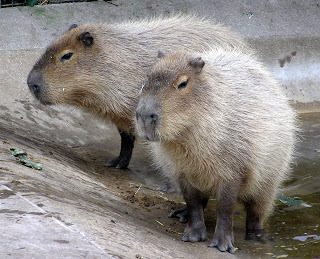 Capybaras (public domain)
Capybaras (public domain)Perhaps the Kintail mystery beast was a capybara, which not only resembles a gigantic guinea pig but is also closely related to guinea pigs. In 1990, an errant capybara named Bert went awol from Porfell Animal Land, near Lanreath, Cornwall, and thrived for 17 months in a man-made fishery close by before being recaptured alive. Bearing in mind, conversely, that its head was a mounted trophy, one can only assume that the Kintail specimen's period of freedom had been curtailed in a rather more terminal manner.
Resolving to unmask this cryptic creature, I tracked down the shop in question, and learnt that the animal was - of all things - a wombat! True, a wombat's head does look a little like that of an outsized guinea pig - but who would ever have imagined that a specimen of so exotic a species as this had been brought to Scotland a century ago (especially when even in modern times wombats have rarely been exhibited in British zoos)?
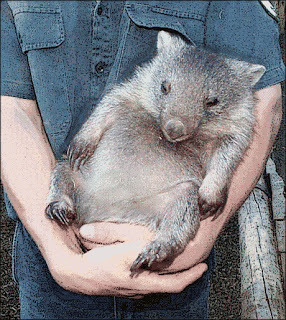 A common wombat Vombatus ursinus (public domain)
A common wombat Vombatus ursinus (public domain)In fact, as I was soon to learn from the shop's owner, this particular wombat had died long before it had ever reached our shores - because it had been killed not in Kintail, Scotland, but in Kintail, Australia, where this marsupial mammal is of course native.
Many years ago, a cartoon in Life Magazine featured a New Jersey farmer visiting a circus where he sees a dromedary for the first time. "There ain't no such animal," exclaims the astonished farmer. Sometimes, I know just how he feels.
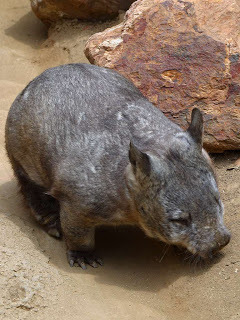 A wombat, the marsupial answer to a woodchuck (public domain)
A wombat, the marsupial answer to a woodchuck (public domain)
Published on May 11, 2013 15:45
May 10, 2013
MY BOOK 'DINOSAURS AND OTHER PREHISTORIC ANIMALS ON STAMPS' WINS AN AWARD!
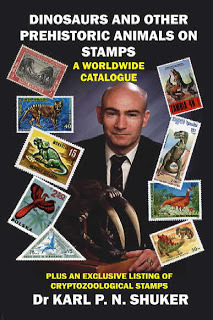
Today I received a most unexpected but very welcome, pleasant surprise. At the 13th New Zealand National Philatelic Literature Exhibition, held on 16 March 2013 at the Manawatu Philatelic Society in Palmerston North, my book Dinosaurs and Other Prehistoric Animals on Stamps: A Worldwide Catalogue (CFZ Press: Bideford, 2008) was awarded a certificate in the highly-prized Large Silver category, in recognition of its significant contribution to philatelic literature. And today I received the certificate in the post from the Society. Here it is:
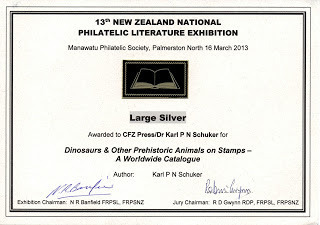 My book's awarded certificate in the Large Silver category (Manawatu Philatelic Society)
My book's awarded certificate in the Large Silver category (Manawatu Philatelic Society)True, they did spell my name incorrectly, but hey, it's the thought that counts! So, many thanks indeed to the judges for deeming my book worthy of such recognition - I am exceedingly grateful.
For full details concerning my book, which also contains an appendix devoted to cryptozoology-themed stamps, click here .
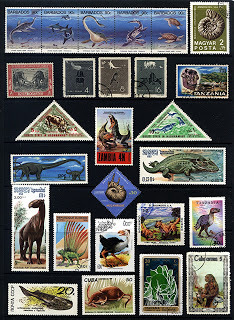 A selection of stamps from my book (Dr Karl Shuker)
A selection of stamps from my book (Dr Karl Shuker)
Published on May 10, 2013 08:03
May 8, 2013
THE NEW GUINEA THYLACINE - CRYING WOLF IN IRIAN JAYA?
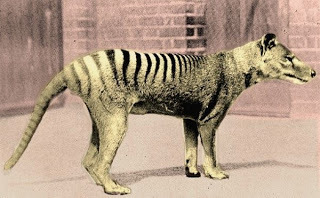 Captive thylacine
Captive thylacineThe official extinction in 1936 on Tasmania of the remarkable thylacine (aka Tasmanian tiger and Tasmanian wolf - Tassie for short) Thylacinus cynocephalus, that tiger-striped canine marsupial mammal as big as a wolf but which could hop like a kangaroo and had a pouch like one too, is well-documented, as is its much earlier disappearance a couple of millennia ago on the Australian mainland. Less familiar, conversely, is the fact that during the Pleistocene epoch, ending a mere 11,700 years ago, the thylacine also existed on New Guinea. Similarly, whereas the chronicles of cryptozoology are fairly bulging with unconfirmed post-1936 thylacine sightings both on Tasmania and in mainland Australia, it is not so well known that modern-day reports of suspiciously thylacine-like beasts have also emerged from New Guinea, specifically Irian Jaya (New Guinea's less-explored western, Indonesian half), where such creatures are referred to by local people as the dobsegna.
A video of living thylacines in captivity (click here )
During the early 1990s, grazier Ned Terry visited Irian Jaya and procured the following details from local testimony. Rarely seen in daylight, the dobsegna generally emerges from its den in rocks or caves at dawn or dusk, to hunt for small prey animals. Its head and shoulders are dog-like, but its mouth is huge and strong, and its tail is very long and thin. Villagers claim that from its ribs to its hips it has no intestines (but this merely suggests that it is very thin in this particular body region), and that in this region it is striped.
 Dorsal view of a living thylacine, showing its impressive striping
Dorsal view of a living thylacine, showing its impressive stripingNeedless to say, this is a remarkably accurate verbal portrait of a thylacine, from the canine head and exceptionally powerful jaws to the slender stripe-adorned hindquarters and lengthy tail. Moreover, in 2003 veteran Irian Jaya explorer Ralf Kiesel confirmed to me that since 1995 there have been persistent rumours of thylacines existing in at least two sections of Irian Jaya's Baliem Valley - the Yali area in the valley's northeast region, and the NP Carstenz in its southwest. The latter area is of particular significance because back in the early 1970s Jan Sarakang, a Papuan friend of Kiesel, had a most startling experience while working with a colleague in the mountains just west of NP Carstenz.
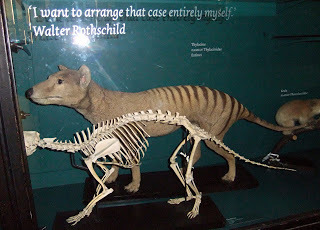 Taxiderm thylacine and mounted skeleton at Tring Natural History Museum, formerly owned by Lord Walter Rothschild (Dr Karl Shuker)
Taxiderm thylacine and mounted skeleton at Tring Natural History Museum, formerly owned by Lord Walter Rothschild (Dr Karl Shuker)They had built a camp for some geologists near Puncac Jaya at an altitude of roughly 1.5 miles and were sitting by their tents that evening, eating their meal, when two unfamiliar dog-like animals emerged from the bush. One was an adult, the other a cub, and both appeared pale in colour, but most striking of all was their stiff, inflexible tails, and the incredible gape of their jaws when they yawned spasmodically. Clearly drawn by the smell of the food, the two animals walked nervously from side to side, eyeing the men and their food supplies, and approaching to within 20 yards. Eventually the cub became bold enough to walk up to the men, who tried to feed it, but when one of them also tried to catch it, the cub bit his hand and both animals then ran back into the bush and were not seen again.
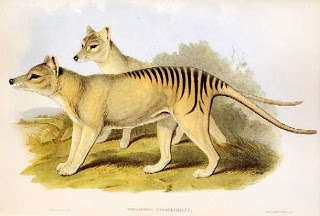 Thylacines (Henry Constantine Richter, 1845)
Thylacines (Henry Constantine Richter, 1845)Except for their seemingly unstriped form, which may well have been a trick of the moonlight, once again these animals recalled thylacines, especially with respect to their stiff tails (a thylacine characteristic) and huge gapes. Worth noting is that the thylacine could open its mouth beyond an amazing 120 degrees - far more than any true dog or wolf can do.
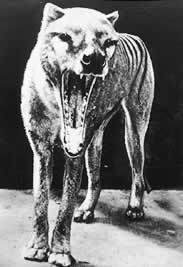 Captive thylacine, revealing its jaws' extraordinarily wide gape
Captive thylacine, revealing its jaws' extraordinarily wide gapeSearches for the thylacine on Tasmania and in mainland Australia continue on a frequent, but habitually unsuccessful, basis. Perhaps it is time for Tassie seekers to turn their attention elsewhere - to the verdant, shadowy mountain forests and caves of Irian Jaya.
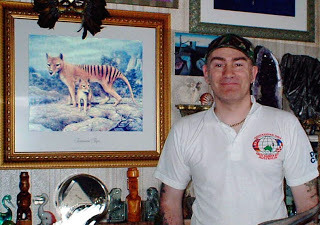 In my study alongside a framed print of an original thylacine painting by Rod Scott, commissioned by Australian Geographic (Dr Karl Shuker)
In my study alongside a framed print of an original thylacine painting by Rod Scott, commissioned by Australian Geographic (Dr Karl Shuker)
Published on May 08, 2013 15:40
May 3, 2013
COBWEB PANTHERS - A SILVERED SURPRISE
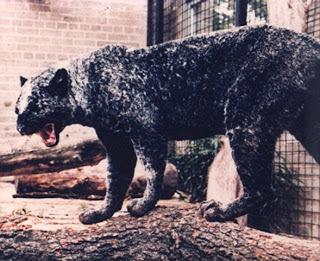 The cobweb panther formerly exhibited at Glasgow Zoo (Graham Law)
The cobweb panther formerly exhibited at Glasgow Zoo (Graham Law)Black panthers, i.e. melanistic leopards, are exotic-looking felids at the best of times, but the individual constituting the principal subject of this present ShukerNature blog post was a truly exceptional female black panther, purchased from Dublin Zoo during the early 1980s, and exhibited for a few years at Glasgow Zoo before being sold overseas, probably destined for Madrid Zoo.
On first sight, one could be forgiven for assuming that this extraordinary animal had recently strolled through an unusually dense sheet of cobwebs, for its entire coat appeared to be covered in a fine white filigree of gossamer. On closer inspection, however, this 'gossamer' proved to be a profuse sprinkling of white hairs among its otherwise uniformly-black coat.
Old black-furred mammals sometimes exhibit a gradual silvering of their fur with advancing age. However, this panther's silvering was so extensive that Richard O'Grady, a former director of Glasgow Zoo, was convinced that it was due to a genetic mutation, and he also noted that its gums were unusually pink. Moreover, although the panther was 10-11 years old when it arrived at Glasgow, Richard had first seen it some time earlier, when it was at Dublin, and it was no less silvered then, again ruling out an age-related explanation.
Consequently, I would assume that the Glasgow Zoo 'cobweb panther' possessed not only the Agouti gene's recessive non-agouti mutant allele (like normal black panthers), but also a mutant allele (of some other gene) for silvering. One writer has claimed that this cat was exhibiting piebaldism, but that is incorrect, because piebaldism typically features entire patches of white skin or fur (piebald horses are a well known example), not merely a sprinkling of white hairs in an otherwise dark pelage.
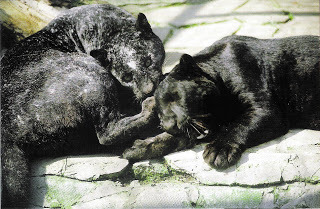 The cobweb panther (left) and a normal black panther (right) at Glasgow Zoo (Graham Law)
The cobweb panther (left) and a normal black panther (right) at Glasgow Zoo (Graham Law)Although she gave birth to various cubs, all of which were black, none developed her remarkable pelage. As I learnt from Graham Law in June 2011:
"She had two litters of cubs that I am aware of, one on the 15/08/1981 consisting of 3 black cubs (gestation 96 days) - 1 DNS [Did Not Survive] leaving 1.1 to be reared. Another on the 24/04/1983 consisting of 1, black, male cub born after a gestation of 99 days. She was always mated to a melanistic male. She was a good mother as she reared two cubs from her first litter at Glasgow and was a calm, easy going individual."
I have been informed that at least one other captive cobweb panther has been recorded, but as yet I have no further details regarding it.
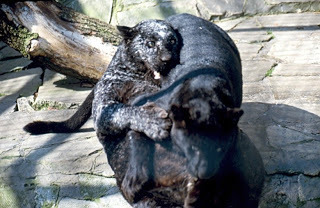 The cobweb panther (underneath) and a normal black panther (on top) at Glasgow Zoo (Graham Law)
The cobweb panther (underneath) and a normal black panther (on top) at Glasgow Zoo (Graham Law)This post is excerpted from my latest book, Cats of Magic, Mythology, and Mystery (CFZ Press: Bideford, 2012); my grateful thanks to Graham Law for so kindly making available his photographs for me to use in this segment of my book.
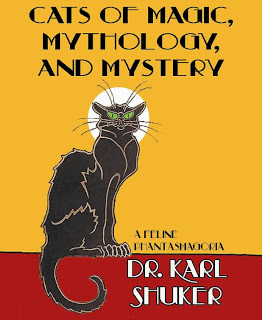
Published on May 03, 2013 16:10
May 1, 2013
SONNERAT'S NON-EXISTENT PENGUINS (AND KOOKABURRA) OF NEW GUINEA
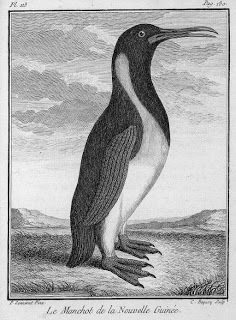 Sonnerat's 'manchot of New Guinea' - in reality, the king penguin
Sonnerat's 'manchot of New Guinea' - in reality, the king penguinAfter I'd added a link on various Facebook group pages to my recent ShukerNature post concerning an extraordinary claim by French naturalist-explorer Pierre Sonnerat (1748-1814) that the Philippines were home to a species of secretary bird (click here ) - a bird entirely confined to Africa - on 26 April 2013 Mike Grayson commented on my Journal of Cryptozoology FB group's page that Sonnerat had also claimed that New Guinea was home to various forms of penguin! Never having encountered this weird allegation by Sonnerat before, I was totally fascinated by it, and resolved to research the matter. This I have done, and I now have pleasure in revealing the truly bizarre history behind it. My sincere thanks to Mike for originally bringing it to my attention.
Pierre Sonnerat was also an artist and a writer, and his publications include Voyage à la Nouvelle-Guinée (1776), documenting an expedition that he claimed to have made to the Spice Islands (now called the Moluccas) and New Guinea in 1771. From an ornithological standpoint, this publication is particularly intriguing, inasmuch as it reports the presence in New Guinea of no less than three species of penguin as well as the common kookaburra or laughing jackass Dacelo novaeguineae. His book even contains illustrations signed by him that depict the penguins as well as the kookaburra, and the brief passage in it concerning the penguins states:
"I will mention the three Manchots [penguins] which I have observed, one the Manchot of New Guinea, another the Collared Manchot of New Guinea, and the third, the Manchot Papua."
In reality, however, New Guinea is unequivocally bereft of any penguin species; and whereas three smaller kookaburra species do occur in New Guinea, the common kookaburra is confined to Australia. So how can these extraordinary discrepancies in Sonnerat's book be explained? The answer is as startling as Sonnerat's unfounded ornithological allegations.
First and foremost: Sonnerat never actually visited New Guinea! His expedition there was a complete fiction, and was publicly exposed during his lifetime. Yet somehow he survived the shame with his scientific reputation intact, and the scandal was subsequently forgotten.
Conversely, his New Guinea penguins were not made-up birds. On the contrary, their respective species can be readily identified from the illustrations of them in his book.
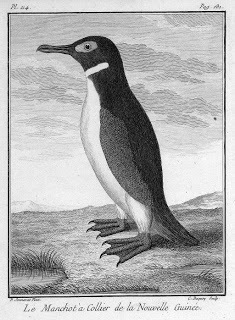 Sonnerat's 'collared manchot of New Guinea' - in reality, the emperor penguin
Sonnerat's 'collared manchot of New Guinea' - in reality, the emperor penguinThe manchot of New Guinea is the king penguin Aptenodytes patagonicus (breeds on northern Antarctica and various subantarctic islands), the collared manchot of New Guinea is the emperor penguin A. forsteri (Antarctica), and the manchot Papua is the gentoo penguin Pygoscelis papua (various subantartic islands including the Falklands).
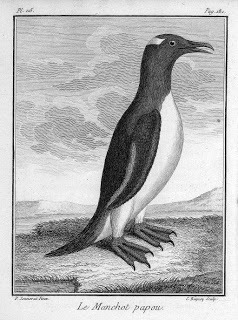 Sonnerat's 'manchot Papua' - in reality, the gentoo penguin
Sonnerat's 'manchot Papua' - in reality, the gentoo penguinAs revealed in Penny Olsen's fascinating book, Feather and Brush: Three Centuries of Australian Bird Art (2001), it transpired that a number of bird skins, including those of the penguin specimens depicted in those illustrations as well as that of the kookaburra specimen depicted in its own illustration, had apparently been given to Sonnerat in 1770 at South Africa's Cape of Good Hope by English naturalist Sir Joseph Banks, who had procured them during his global travels in the 1760s.
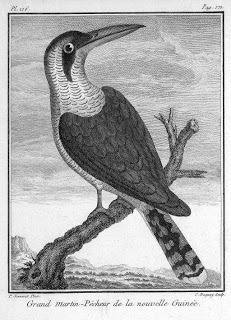 Sonnerat's 'New Guinea common kookaburra' - in reality, the Australian common kookaburra
Sonnerat's 'New Guinea common kookaburra' - in reality, the Australian common kookaburraBanks instructed Sonnerat to deliver them to fellow naturalist Dr Philibert Commerson in Mauritius. So Sonnerat sailed there, giving the skins to Commerson's draughtsman, Paul Philippe Sanguin de Jossigny, who sketched them. Following Commerson's premature death in 1773, however, Sonnerat not only kept Jossigny's illustrations of the penguins and kookaburra, but unscrupulously signed them, passing them off as his own work, and including them in his book on New Guinea.
Sadly, vestiges of Sonnerat's deception persists even today, in the misleading scientific names of the gentoo penguin and the kookaburra, which to anyone not familiar with their correct zoogeographical range suggests that the former species is native to Papua and the latter species to New Guinea.
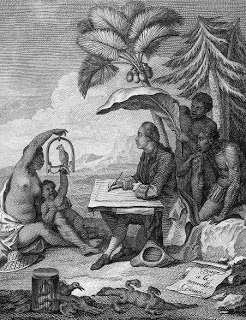 Engraving of Pierre Sonnerat, engaged in sketching a bird
Engraving of Pierre Sonnerat, engaged in sketching a bird
Published on May 01, 2013 14:42
April 25, 2013
SEEKING SECRETARY BIRDS IN SOUTHEAST ASIA?
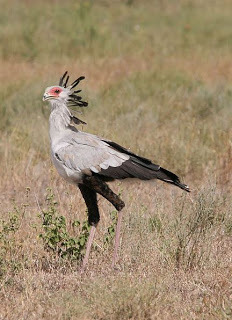 The secretary bird (Yoky-Wikipedia)
The secretary bird (Yoky-Wikipedia)My late mother, Mary Doreen Shuker, was a short-hand typist and secretary throughout her working life, and I fondly recall how I used to joke affectionately with her that this made her a secretary bird - the name given to that elegant and endemic African bird of prey known scientifically as Sagittarius serpentarius. Although this is a very familiar species, much less familiar is that it has a cryptozoological counterpart, reported far from African shores - in the Philippines, no less. So here, dedicated with all my love to my dear little Mom, is my investigation of this very intriguing Asian mystery bird.
Imagine, if you will, a grey-plumaged hawk that for some unexplained reason has been invested with the long slender legs and neck of a stork, bestowing upon it a total height of 3.5-4 ft when standing upright. Combined with these is a pair of extremely lengthy, black-pinioned wings attaining a span of 7 ft when fully extended, plus an elegant, elongated tail. Lastly, added almost as an absurd afterthought (judging from its somewhat disorderly appearance), is a crest of drooping, black-tipped feathers that conjure up the incongruous image of a office scribe with an untidy sheaf of quill pens protruding from behind his ear!
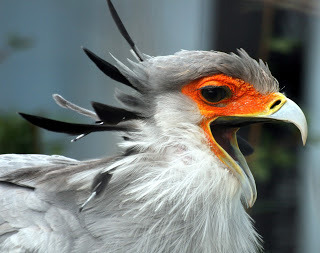 The head of a secretary bird, showing its diagnostic crest (Kevin Law-Wikipedia)
The head of a secretary bird, showing its diagnostic crest (Kevin Law-Wikipedia)The product of this exercise in creature composition will probably be a surprisingly accurate reconstruction of a truly singular species of African bird, known scientifically as Sagittarius serpentarius - the secretary bird.
Named after its manner of stalking on foot in long, measured strides like an archer preparing to shoot his arrows, and also after its passion for attacking and devouring serpents great and small, only one modern-day species of secretary bird is currently recognised. Back in 1835, however, English zoologist William Ogilby attempted to distinguish three - and, in so doing, created a very curious if little-known cryptozoological enigma.
One of his three species comprised the secretary bird populations of eastern, central, and southern Africa; and another constituted those from western Africa's Senegambia region. The third, and by far the most unexpected, conversely, was based upon an illustrated description by French naturalist Pierre Sonnerat within his Voyage dans la Nouvelle-Guinée (1776) of an alleged variety of secretary bird existing very much further afield - in the Philippines!
As there are certainly no secretary birds indigenous to these (or any other) southeast Asian islands, the least contentious answer to this zoogeographical riddle is that Sonnerat's description must have been founded upon specimens brought there by man, probably as exotic exhibits (though no evidence for any such introductions is currently known to me). To my mind, however, there is another possible explanation - rather more remote, but much more interesting from the standpoint of ornithological discovery.
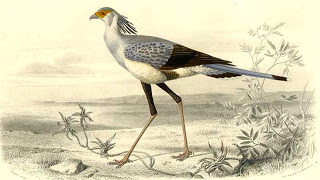 Early colour engraving of a secretary bird from Dictionnaire Histoire Naturelle by Charles Orbigny
Early colour engraving of a secretary bird from Dictionnaire Histoire Naturelle by Charles OrbignyThe largest bird of prey known to be native to the Philippines is a magnificent crested species called Pithecophaga jefferyi, the monkey-eating or Philippine eagle (traditionally thought to be closely related to the Amazonian harpy eagle, but now, following DNA comparisons, revealed to be akin to the snake eagles). Sonnerat's description (and inaccurate depiction) of his supposed Philippine secretary bird contained certain morphological characters that set it well apart from the bona fide African version, yet which recalled this very impressive Asian eagle.
For example, Sonnerat recorded that the feathers constituting the lower portion of the Philippine secretary bird's crest were longer than those of its upper portion. This is the exact converse of the crest structure in Africa's Sagittarius, but is suggestive of Pithecophaga. Similarly, whereas the central feathers are the longest ones in the tail of Sagittarius, Sonnerat claimed that the outermost feathers were the longest ones in the tail of its Philippine counterpart - a condition agreeing once again with that of Pithecophaga.
From these and other correspondences, it is possible that Sonnerat's description of what we now know to be a non-existent Philippine secretary bird was inspired at least in part by vague, second-hand accounts of Pithecophaga, the Philippine eagle.
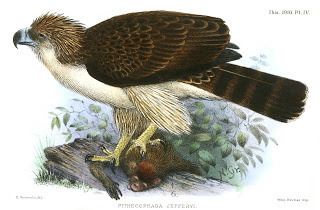 Colour engraving of a Philippine eagle
Colour engraving of a Philippine eagleIf this is so, it is an especially interesting and cryptozoologically significant case (albeit until my investigations of it a long-forgotten one), because at the time of Sonnerat's report Pithecophaga was still undiscovered by science. Not until it was formally described and named just over a century later by W.R. Ogilvie-Grant in 1896 did the existence of this spectacular species finally become known to the ornithological world. And certainly, if the so-called Philippine secretary bird is indeed one and the same as the Philippine eagle, it would not be the first time that accounts of a creature have actually appeared in the literature long before that creature's reality has been recognised, and its true identity unveiled, by science.
Speaking of out-of-place secretary birds: it is fully confirmed that in 1832 this snake-eating species was introduced onto the West Indian island of Martinique, in order to eliminate the highly-venomous yellow fer-de-lance Bothrops (=Trigonocephalus) lanceolatus. However, it failed to establish itself here - but this failure is probably no bad thing. After all, as the secretary bird is partial not only to snakes but also to small birds, especially ground-dwelling types, its permanent presence on Martinique may well have endangered this island’s native avifauna - in turn affording another example of the disastrous events that can be set in motion when humankind attempts to meddle with an ecosystem's natural balance.
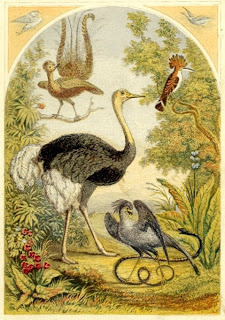 Beautiful antiquarian colour engraving of various avifauna, including a secretary bird battling a snake
Beautiful antiquarian colour engraving of various avifauna, including a secretary bird battling a snakeThis ShukerNature blog post is excerpted and updated from my book Extraordinary Animals Revisited (2007).

Published on April 25, 2013 12:39
April 16, 2013
IN MEMORIAM – MY EULOGY TO MY DEAR MOTHER, MARY DOREEN SHUKER (1921-2013)
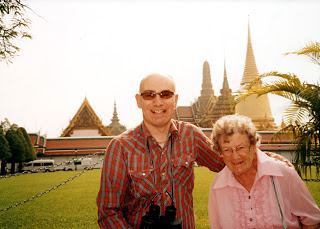 Mom and I at the Royal Palaces, Bangkok, Thailand, 2005 – our Far East holiday was her all-time favourite, visiting all of the wonderfully exotic lands of the Orient that she had wanted so much to see all her life but had never thought that she would (Dr Karl Shuker)
Mom and I at the Royal Palaces, Bangkok, Thailand, 2005 – our Far East holiday was her all-time favourite, visiting all of the wonderfully exotic lands of the Orient that she had wanted so much to see all her life but had never thought that she would (Dr Karl Shuker)"Say not in grief 'she is no more' but live in thankfulness that she was."
"You can shed tears that she is gone, or you can smile that she has lived."
(Variations upon a traditional Hebrew proverb)
Today was the funeral of my beloved mother, Mary Doreen Shuker, who passed away on Easter Monday 2013, following a mercifully brief period of debilitation caused by the combined effects of various old-age-related conditions. She was 92 years old, and until then had been in exceptionally good health throughout her life – a life that I was truly privileged to share throughout my own. Whatever good may be in me came from my little Mom (as I always affectionately called her); she was a profound influence in all of my own interests, including cryptozoology (click here to discover why I owe my abiding passion for cryptozoology to her); and when she passed away, I truly felt (and still feel) that part of me, the best part, died with her.
Due to the existence and public awareness of my writings and researches, googling my name will call up many entries on the internet relating to me, but when I googled my Mom's name recently I was extremely sad, and angry, to discover that there were only two entries – and both of those were references to her in ShukerNature blog posts of mine. In other words, as far as the world as measured by internet presence was concerned, her entire life had barely registered. On more than one occasion, Mom had stated that whereas my contributions to this world were my writings, and for which I would always be remembered, her sole contribution, the only thing that she felt she would ever be remembered for, would be having given birth to me, but that this was more than enough, and made her feel very proud. However, as far as I am concerned, it is certainly not enough – because my mother was a truly remarkable, wonderful person, who made me the person I am today, and to whom I owe everything.
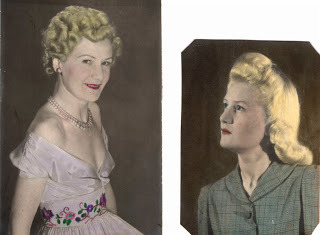 Two hand-tinted photographs of my mother when she was in her mid-20s – beautiful on the outside as well as on the inside (© Mary D. Shuker/Dr Karl Shuker)
Two hand-tinted photographs of my mother when she was in her mid-20s – beautiful on the outside as well as on the inside (© Mary D. Shuker/Dr Karl Shuker)Consequently, in order to document all of this in the fullest, most appropriate way that I possibly can, for the entire world to know just how very special my mother was – and always will be - I now present the eulogy that I wrote and read aloud to her at her funeral today (and I am interspersing it with some of my favourite photographs of her and of the two of us together). I only pray that it did justice to the best person I shall ever know.
Hello little Mom - you'll always be my dear sweet innocent little Mom.
Well, here we are, just the two of us together today, just like you wanted – you always said that the only person you wanted here today was me, and I'm here for you, Mom, as always. We're side by side, united as one, just like we've always been. As long as we're together, that's all that matters, that's all that's ever mattered.
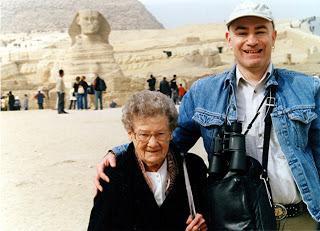 Mom and I visiting the Great Sphinx at Giza, Egypt, January 2006 (Dr Karl Shuker)
Mom and I visiting the Great Sphinx at Giza, Egypt, January 2006 (Dr Karl Shuker)It would take me many lifetimes to tell you just how much I love you, little Mom, and how thankful I am to you in countless different ways, but in the time that I have here with you now, I need so much to tell you the important things that mean the very most.
Please, though, don't think badly of me, Mom, for having written all of this down rather than just saying what comes into my mind. I just couldn't take the risk of being so distressed that my mind froze, or I stuttered and stumbled, or forgot to say something essential. This is for you, so I want it to be perfect in every way, because that's what you are.
 Mom and a very little moai on Easter Island, 2008 (Dr Karl Shuker)
Mom and a very little moai on Easter Island, 2008 (Dr Karl Shuker)First of all, I love you Mom with all of my heart, and I know that you love me the same too, because love never dies. You've always been the perfect Mom, no-one could have ever been blessed with a kinder, better mother – you were born to be a mother, and I am truly truly blessed that you are mine and that I have been embraced throughout my life by your unfaltering, eternal love.
It's thanks to your precious love, your ever-present loyalty and support, your constant encouragement, your lifelong inspiration, and your practical wisdom that I have always sought and have always received whenever I've needed advice, help, or even just a sympathetic ear to listen to all of my problems, that I am who I am today, Mom. We were always much more than son and mother - we were also best friends, kindred spirits, who shared the same interests, liked the same things, and understood each other like no one else ever could or ever will. And that is how we will always remain. You will no longer be present beside me in the physical sense, Mom, though I shall always wish that you were and I shall miss seeing you, talking to you, and just being with you more than I can ever say; but you will be forever in my thoughts, in my memories (all of which are good ones), and in my heart, all the days of my life.
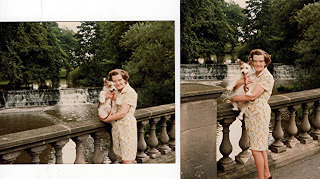 Mom and my little Jack Russell terrier Patch, mid-/late 1970s (Dr Karl Shuker)
Mom and my little Jack Russell terrier Patch, mid-/late 1970s (Dr Karl Shuker)Whatever good may be in me, whatever creativity I have displayed, whatever positivity I possess, they all come directly from you, Mom. Your own love of nature and animals and also of books and literature nurtured mine too, ultimately leading me to become a zoologist and a full-time, professional, published author on cryptozoology and other wildlife subjects. And your own skills as a secretary and perfect command of the English language were willingly made available to me by you when we were checking the proofs of my books together back in the pre-computerised days of publishing. Remember how we used to sit together for hours, meticulously going through them?
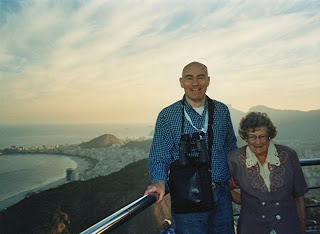 Mom and I at sunset on top of Corcovado Mountain, Rio de Janeiro, Brazil, 2007 (Dr Karl Shuker)
Mom and I at sunset on top of Corcovado Mountain, Rio de Janeiro, Brazil, 2007 (Dr Karl Shuker)And your fond wish to be able to travel the world one day and for me to see many of its wonders and marvels led you some years after retiring to go back to work, taking on a part-time secretarial post, in order to earn enough money to fund us on our travels while I was still just a teenager to many fantastic destinations in Europe, as well as North Africa and even a holiday in the USA. And these sights inspired me when I became a man to continue journeying to even more exotic, fascinating locations, and I always took you with me, Mom, to show you all the places that you'd dreamed of seeing but never expected to – remember Easter Island and Rio de Janeiro, Singapore and Hong Kong, Thailand, Las Vegas, Egypt, Niagara Falls, New Zealand, and Cape Town in South Africa? We visited all of these and many more, didn't we, Mom? And our adventures in those fabulous faraway places will remain some of my most treasured memories of all time.
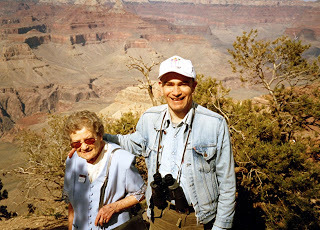 Mom and I at the Grand Canyon, Arizona, USA, 2004 (Dr Karl Shuker)
Mom and I at the Grand Canyon, Arizona, USA, 2004 (Dr Karl Shuker)However, we've both had tough things happen in our lives too, but together we've always seen them through – you and me against the world - somehow we've always managed to come through relatively unscathed together, until this last, final confrontation came along. And although we battled it together as we've always done, it was simply one too many for you, Mom, at 92, to take on and win, even with me at your side and fighting it with you and for you every step of the way as ever. On the holy day of Easter Monday, God looked down upon us and in His infinite kindness He granted you the gifts of peace and release from this mortal world of pain and grief. In so doing, He brought me more grief and sorrow than I have ever thought it possible for the world to hold, but I completely understand and accept that His decision was as ever the correct one. Neither He nor I would have wanted you to suffer, and He also blessed us with the ultimate gift that He could bestow upon us – He allowed me to be with you at the very end, little Mom, so that you were not alone, and to hold your hand, to stroke your brow, to tell you everything that I wanted and needed to tell you, and to kiss you goodbye, for now. And for all of this, I shall be eternally grateful to God, for His kindness and for the greatest blessing that He could ever have given to us. Thank you, dear Lord.
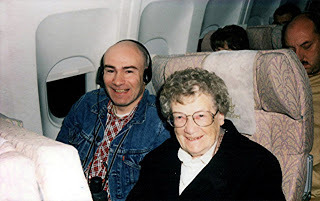 Mom and I on our Emirates flight out from England to Dubai and the Far East, 2005 (Dr Karl Shuker)
Mom and I on our Emirates flight out from England to Dubai and the Far East, 2005 (Dr Karl Shuker)I'm wearing your wedding ring from now on, Mom, on my little finger, where it fits perfectly. So now, you'll be with me again; whenever I look at it or touch it, you'll be there, to give me strength, courage, and your support, just like you've always done. And do you remember that lovely belt buckle and belt you bought me years and years ago from Great Bridge? I always loved it so much, but I wore it so much, year in year out, that the buckle eventually fell apart, and I was really upset when that happened. I thought it was beyond repair, but a friend mended it for me a few days ago, so I'm wearing it today and will be wearing it all the time from now on too.
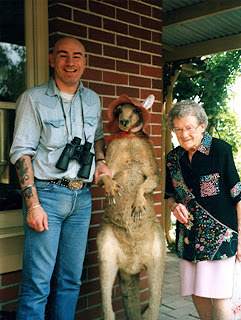 Mom and I and a marsupial scene-stealer in Melbourne, Australia, 2006; I'm wearing that lovely belt and buckle that Mom bought me all those years earlier (Dr Karl Shuker)
Mom and I and a marsupial scene-stealer in Melbourne, Australia, 2006; I'm wearing that lovely belt and buckle that Mom bought me all those years earlier (Dr Karl Shuker)And that beautiful silver-and-turquoise Nubian scarab bracelet that I bought for you on your birthday in Luxor, Egypt, and which you've always worn on your arm ever since, it's now on display on top of your beautiful lacquered television cabinet in the lounge, where I can always see it. And don't worry about the rings that you were wearing on Easter Monday, Mom, I have them all at home, safe and sound, and your big blue sheepskin jacket I bought you that you were wearing too, together with your alpaca jumper from Chile and your other clothes from that day. Everything's back home and fine, Mom, I made sure of all of that for you.
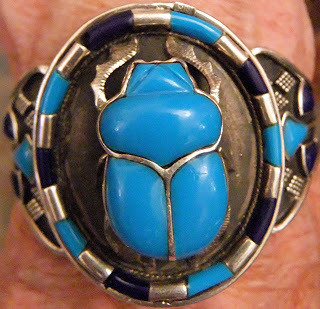 The Nubian scarab bracelet that I bought for Mom on her 85th birthday in Luxor, Egypt; the scarab symbolises resurrection and eternal life (Dr Karl Shuker)
The Nubian scarab bracelet that I bought for Mom on her 85th birthday in Luxor, Egypt; the scarab symbolises resurrection and eternal life (Dr Karl Shuker)Back in 1989, I dedicated my first book, Mystery Cats of the World, to my family, past and present, for love and unwavering support. Two years later, I dedicated my second book, Extraordinary Animals Worldwide, specifically to you, Mom, with the following words: "To my mother, Mary D. Shuker, whose lifelong interest in wildlife has guided and encouraged my own since my earliest days", followed by a short quote from Life Thoughts by Henry Ward Beecher: "The mother's heart is the child's schoolroom". No words were ever a better description of how you inspired me than those.
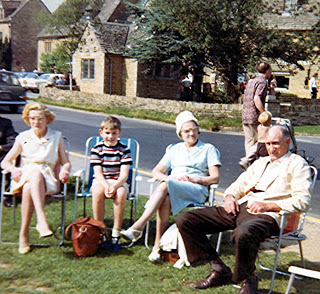 Mom, me, Nan, and Dad at Bourton-on-the-Water, Gloucestershire, late 1960s (Dr Karl Shuker)
Mom, me, Nan, and Dad at Bourton-on-the-Water, Gloucestershire, late 1960s (Dr Karl Shuker)I am also dedicating to you, Mom, my latest book, Mirabilis, the American one that I've told you about. Here is my dedication, straight from the manuscript, and which I feel sums up everything that I could ever hope to express to you:
In memory of my dear mother, Mary Doreen Shuker (1921-2013)
Whatever good there may be in me came from you.Thank you for blessing my life by being in it as my mother.You were, are, and always will be quite simply the best person I shall ever know,and I love you with all of my heart.God bless you, little Mom,please wait for me,watch over me in this lonely existence of mine now,and come for me when my time here is over.Au revoir, Mom, until we meet again.
And I do mean au revoir, not goodbye, so I am not saying goodbye here, Mom, only, until we meet again, as we will surely do with God's grace.
I love you, little Mom, always.
 The lid of the memory box that I have bought for Mom – its quotation describes her so well that it could have been written specifically for her (Dr Karl Shuker)
The lid of the memory box that I have bought for Mom – its quotation describes her so well that it could have been written specifically for her (Dr Karl Shuker)God bless you, Mom – thank you for everything that has ever been good in my life. How I wish that you were still here with me, fit and well, ready to set off with me on our next adventure together.
I love you, little Mom, always.
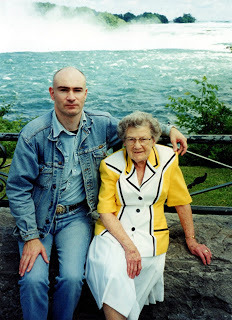 Mom and I at Niagara Falls, Canada, 2000 (Dr Karl Shuker)
Mom and I at Niagara Falls, Canada, 2000 (Dr Karl Shuker)And now, as a pictorial tribute to my mother, here are some more of my favourite photos of her and of us together (click on them to enlarge them), sharing that great adventure called life, with love.
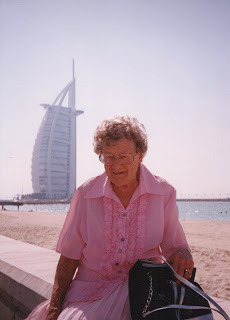 Mom and the Burj al-Arab Hotel, Dubai, UAE, 2005 (Dr Karl Shuker)
Mom and the Burj al-Arab Hotel, Dubai, UAE, 2005 (Dr Karl Shuker)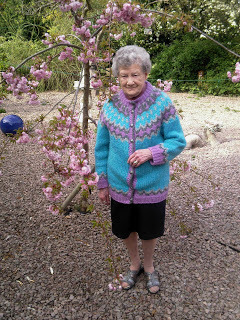 Mom in our back garden alongside our weeping cherry blossom tree and the water dragon, 2009 (Dr Karl Shuker)
Mom in our back garden alongside our weeping cherry blossom tree and the water dragon, 2009 (Dr Karl Shuker)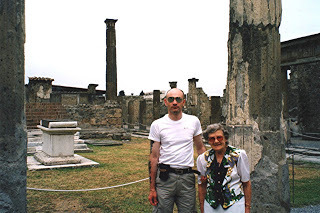 Mom and I at Pompeii, Italy, 2001 (Dr Karl Shuker)
Mom and I at Pompeii, Italy, 2001 (Dr Karl Shuker)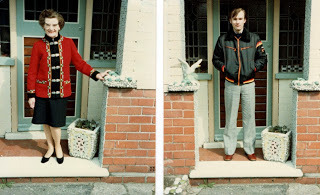 Mom and I at our front door at our previous home, early 1980s (Dr Karl Shuker)
Mom and I at our front door at our previous home, early 1980s (Dr Karl Shuker)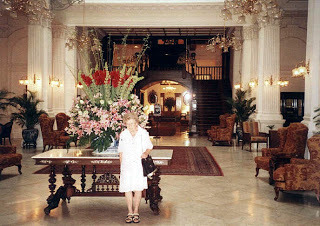 Mom at Raffles Hotel, where we stayed when visiting Singapore in 2006, thereby transforming into reality for her another of her lifelong dreams (Dr Karl Shuker)
Mom at Raffles Hotel, where we stayed when visiting Singapore in 2006, thereby transforming into reality for her another of her lifelong dreams (Dr Karl Shuker)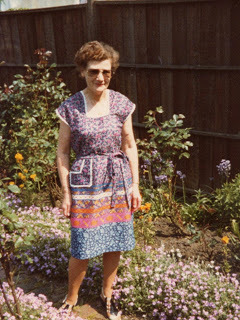 Mom in the garden of my Nan (Mom's mother), early 1980s (Dr Karl Shuker)
Mom in the garden of my Nan (Mom's mother), early 1980s (Dr Karl Shuker)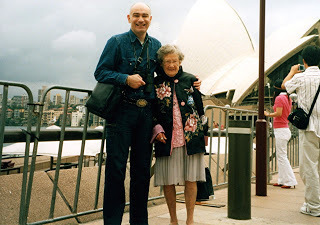 Mom and I at the Sydney Opera House, Australia, 2006 (Dr Karl Shuker)
Mom and I at the Sydney Opera House, Australia, 2006 (Dr Karl Shuker) Mom at the Trevi Fountain, Rome, Italy, 2001 – she never did tell me what she wished for when she tossed her coin into the fountain, but I hope that whatever it was, the fountain granted it for her (Dr Karl Shuker)
Mom at the Trevi Fountain, Rome, Italy, 2001 – she never did tell me what she wished for when she tossed her coin into the fountain, but I hope that whatever it was, the fountain granted it for her (Dr Karl Shuker)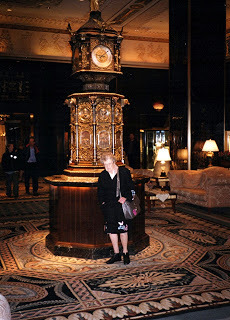 Mom at the Waldorf-Astoria Hotel where we stayed when visiting New York in 2004 – one wish of hers that I was able to fulfil for her (Dr Karl Shuker)
Mom at the Waldorf-Astoria Hotel where we stayed when visiting New York in 2004 – one wish of hers that I was able to fulfil for her (Dr Karl Shuker)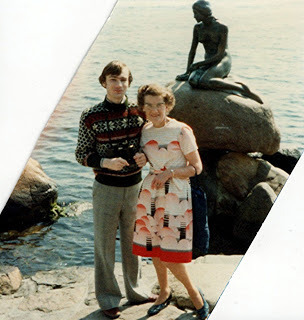 Mom and I with the Little Mermaid statue in Copenhagen, Denmark, 1979 (Dr Karl Shuker)
Mom and I with the Little Mermaid statue in Copenhagen, Denmark, 1979 (Dr Karl Shuker)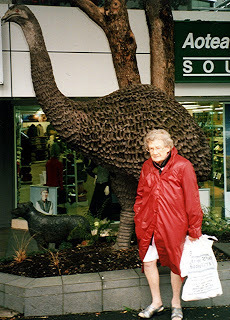 Mom and a moa statue on a rainy day in Auckland, New Zealand, 2006 (Dr Karl Shuker)
Mom and a moa statue on a rainy day in Auckland, New Zealand, 2006 (Dr Karl Shuker)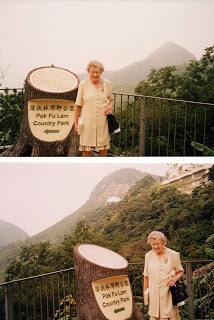 Mom at Victoria Peak, Hong Kong, 2005 (Dr Karl Shuker)
Mom at Victoria Peak, Hong Kong, 2005 (Dr Karl Shuker)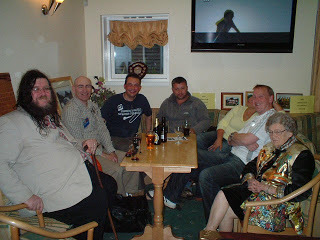 Mom and I with Jonathan Downes, Adam Davies, Keith, and Dave Archer at Weird Weekend 2008 (Dr Karl Shuker)
Mom and I with Jonathan Downes, Adam Davies, Keith, and Dave Archer at Weird Weekend 2008 (Dr Karl Shuker)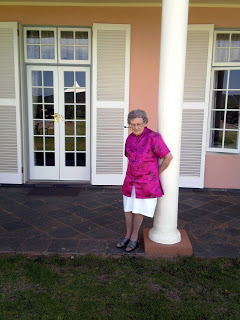 Mom at Long Lee Manor, Shamwari Private Game Reserve, South Africa, 2008 (Dr Karl Shuker)
Mom at Long Lee Manor, Shamwari Private Game Reserve, South Africa, 2008 (Dr Karl Shuker)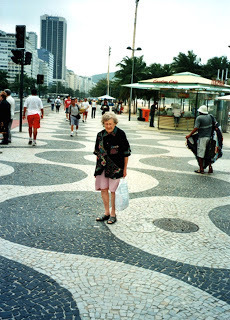 Mom on the Copacabana pavewalk, Rio de Janeiro, Brazil, 2007 (Dr Karl Shuker)
Mom on the Copacabana pavewalk, Rio de Janeiro, Brazil, 2007 (Dr Karl Shuker) Mom and I at the Cat Street Gallery, Hong Kong, 2005 (Dr Karl Shuker)
Mom and I at the Cat Street Gallery, Hong Kong, 2005 (Dr Karl Shuker)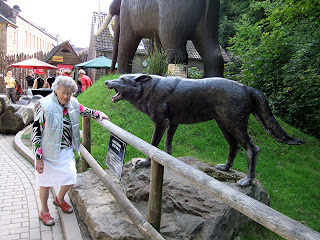 Mom and a dire wolf at Wookey Hole's Dinosaur Valley, Somerset, 2010 (Dr Karl Shuker)
Mom and a dire wolf at Wookey Hole's Dinosaur Valley, Somerset, 2010 (Dr Karl Shuker) Mom and a Megalosaurus statue at Crystal Palace, London, 2010 (Dr Karl Shuker)
Mom and a Megalosaurus statue at Crystal Palace, London, 2010 (Dr Karl Shuker)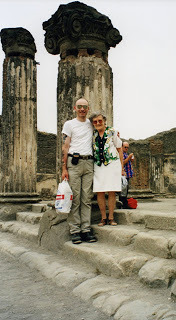 In step with each other, as always – Mom and I at Pompeii, Italy, 2001 (Dr Karl Shuker)
In step with each other, as always – Mom and I at Pompeii, Italy, 2001 (Dr Karl Shuker)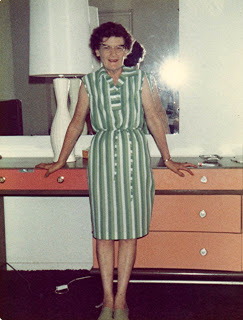 Mom in her Miami hotel room, Florida, USA, 1981 (Dr Karl Shuker)
Mom in her Miami hotel room, Florida, USA, 1981 (Dr Karl Shuker)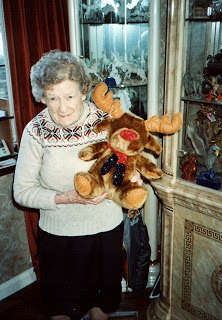 Mom and Rudolf, whom we duly rescued after finding him looking very forlorn hidden away on a shelf at a warehouse sale about 10 years ago (Dr Karl Shuker)
Mom and Rudolf, whom we duly rescued after finding him looking very forlorn hidden away on a shelf at a warehouse sale about 10 years ago (Dr Karl Shuker)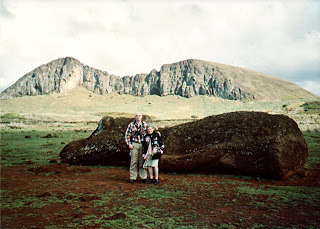 Mom and I in front of a fallen moai on Easter Island, 2008 (Dr Karl Shuker)
Mom and I in front of a fallen moai on Easter Island, 2008 (Dr Karl Shuker) Mom at the Kennedy Space Center, Florida, USA, 1981 (Dr Karl Shuker)
Mom at the Kennedy Space Center, Florida, USA, 1981 (Dr Karl Shuker)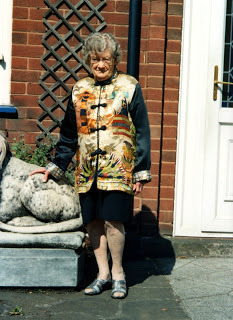 Mom wearing her much-loved Egyptian-themed jacket from Las Vegas (Dr Karl Shuker)
Mom wearing her much-loved Egyptian-themed jacket from Las Vegas (Dr Karl Shuker)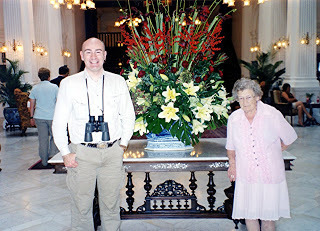 Mom and I at Raffles Hotel, Singapore, 2005 (Dr Karl Shuker)
Mom and I at Raffles Hotel, Singapore, 2005 (Dr Karl Shuker)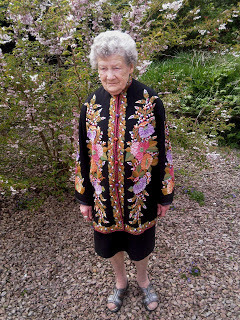 Mom wearing her exquisite protea-decorated jacket from Cape Town, South Africa (Dr Karl Shuker)
Mom wearing her exquisite protea-decorated jacket from Cape Town, South Africa (Dr Karl Shuker)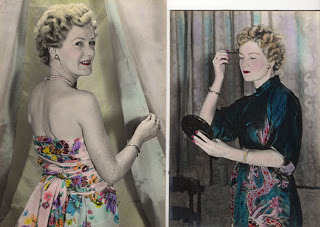 My kind, beautiful, inspirational, and totally amazing mother, Mary Doreen Shuker, aged mid-20s – thank you, Little Mom, for 53 wonderful years of shared happiness, adventures, loyalty, and love (© Mary D. Shuker/Dr Karl Shuker)
My kind, beautiful, inspirational, and totally amazing mother, Mary Doreen Shuker, aged mid-20s – thank you, Little Mom, for 53 wonderful years of shared happiness, adventures, loyalty, and love (© Mary D. Shuker/Dr Karl Shuker)God bless you, Mom.
With all my love, always.
Published on April 16, 2013 14:38
IN MEMORIAM – MY EULOGY TO MY DEAR MOTHER, MARY DOREEN SHUKER, 29 JANUARY 1921 – 1 APRIL 2013
 Mom and I at the Royal Palaces, Bangkok, Thailand, 2005 – our Far East holiday was her all-time favourite, visiting all of the wonderfully exotic lands of the Orient that she had wanted so much to see all her life but had never thought that she would (Dr Karl Shuker)
Mom and I at the Royal Palaces, Bangkok, Thailand, 2005 – our Far East holiday was her all-time favourite, visiting all of the wonderfully exotic lands of the Orient that she had wanted so much to see all her life but had never thought that she would (Dr Karl Shuker)"Say not in grief 'she is no more' but live in thankfulness that she was."
"You can shed tears that she is gone, or you can smile that she has lived."
(Variations upon a traditional Hebrew proverb)
Today was the funeral of my beloved mother, Mary Doreen Shuker, who passed away on Easter Monday, 1 April, 2013 following a mercifully brief period of debilitation caused by the combined effects of various old-age-related conditions. She was 92 years old, and until then had been in exceptionally good health throughout her life – a life that I was truly privileged to share throughout my own. Whatever good may be in me came from my little Mom (as I always affectionately called her); she was a profound influence in all of my own interests, including cryptozoology (click here to discover why I owe my abiding passion for cryptozoology to her); and when she passed away, I truly felt (and still feel) that part of me, the best part, died with her.
Due to the existence and public awareness of my writings and researches, googling my name will call up many entries on the internet relating to me, but when I googled my Mom's name recently I was extremely sad, and angry, to discover that there were only two entries – and both of those were references to her in ShukerNature blog posts of mine. In other words, as far as the world as measured by internet presence was concerned, her entire life had barely registered. On more than one occasion, Mom had stated that whereas my contributions to this world were my writings, and for which I would always be remembered, her sole contribution, the only thing that she felt she would ever be remembered for, would be having given birth to me, but that this was more than enough, and made her feel very proud. However, as far as I am concerned, it is certainly not enough – because my mother was a truly remarkable, wonderful person, who made me the person I am today, and to whom I owe everything.
 Two hand-tinted photographs of my mother when she was in her mid-20s – beautiful on the outside as well as on the inside (© Mary D. Shuker/Dr Karl Shuker)
Two hand-tinted photographs of my mother when she was in her mid-20s – beautiful on the outside as well as on the inside (© Mary D. Shuker/Dr Karl Shuker)Consequently, in order to document all of this in the fullest, most appropriate way that I possibly can, for the entire world to know just how very special my mother was – and always will be - I now present the eulogy that I wrote and read aloud to her at her funeral today (and I am interspersing it with some of my favourite photographs of her and of the two of us together). I only pray that it did justice to the best person I shall ever know.
Hello little Mom - you'll always be my dear sweet innocent little Mom.
Well, here we are, just the two of us together today, just like you wanted – you always said that the only person you wanted here today was me, and I'm here for you, Mom, as always. We're side by side, united as one, just like we've always been. As long as we're together, that's all that matters, that's all that's ever mattered.
 Mom and I visiting the Great Sphinx at Giza, Egypt, January 2006 (Dr Karl Shuker)
Mom and I visiting the Great Sphinx at Giza, Egypt, January 2006 (Dr Karl Shuker)It would take me many lifetimes to tell you just how much I love you, little Mom, and how thankful I am to you in countless different ways, but in the time that I have here with you now, I need so much to tell you the important things that mean the very most.
Please, though, don't think badly of me, Mom, for having written all of this down rather than just saying what comes into my mind. I just couldn't take the risk of being so distressed that my mind froze, or I stuttered and stumbled, or forgot to say something essential. This is for you, so I want it to be perfect in every way, because that's what you are.
 Mom and a very little moai on Easter Island, 2008 (Dr Karl Shuker)
Mom and a very little moai on Easter Island, 2008 (Dr Karl Shuker)First of all, I love you Mom with all of my heart, and I know that you love me the same too, because love never dies. You've always been the perfect Mom, no-one could have ever been blessed with a kinder, better mother – you were born to be a mother, and I am truly truly blessed that you are mine and that I have been embraced throughout my life by your unfaltering, eternal love.
It's thanks to your precious love, your ever-present loyalty and support, your constant encouragement, your lifelong inspiration, and your practical wisdom that I have always sought and have always received whenever I've needed advice, help, or even just a sympathetic ear to listen to all of my problems, that I am who I am today, Mom. We were always much more than son and mother - we were also best friends, kindred spirits, who shared the same interests, liked the same things, and understood each other like no one else ever could or ever will. And that is how we will always remain. You will no longer be present beside me in the physical sense, Mom, though I shall always wish that you were and I shall miss seeing you, talking to you, and just being with you more than I can ever say; but you will be forever in my thoughts, in my memories (all of which are good ones), and in my heart, all the days of my life.
 Mom and my little Jack Russell terrier Patch, mid-/late 1970s (Dr Karl Shuker)
Mom and my little Jack Russell terrier Patch, mid-/late 1970s (Dr Karl Shuker)Whatever good may be in me, whatever creativity I have displayed, whatever positivity I possess, they all come directly from you, Mom. Your own love of nature and animals and also of books and literature nurtured mine too, ultimately leading me to become a zoologist and a full-time, professional, published author on cryptozoology and other wildlife subjects. And your own skills as a secretary and perfect command of the English language were willingly made available to me by you when we were checking the proofs of my books together back in the pre-computerised days of publishing. Remember how we used to sit together for hours, meticulously going through them?
 Mom and I at sunset on top of Corcovado Mountain, Rio de Janeiro, Brazil, 2007 (Dr Karl Shuker)
Mom and I at sunset on top of Corcovado Mountain, Rio de Janeiro, Brazil, 2007 (Dr Karl Shuker)And your fond wish to be able to travel the world one day and for me to see many of its wonders and marvels led you some years after retiring to go back to work, taking on a part-time secretarial post, in order to earn enough money to fund us on our travels while I was still just a teenager to many fantastic destinations in Europe, as well as North Africa and even a holiday in the USA. And these sights inspired me when I became a man to continue journeying to even more exotic, fascinating locations, and I always took you with me, Mom, to show you all the places that you'd dreamed of seeing but never expected to – remember Easter Island and Rio de Janeiro, Singapore and Hong Kong, Thailand, Las Vegas, Egypt, Niagara Falls, New Zealand, and Cape Town in South Africa? We visited all of these and many more, didn't we, Mom? And our adventures in those fabulous faraway places will remain some of my most treasured memories of all time.
 Mom and I at the Grand Canyon, Arizona, USA, 2004 (Dr Karl Shuker)
Mom and I at the Grand Canyon, Arizona, USA, 2004 (Dr Karl Shuker)However, we've both had tough things happen in our lives too, but together we've always seen them through – you and me against the world - somehow we've always managed to come through relatively unscathed together, until this last, final confrontation came along. And although we battled it together as we've always done, it was simply one too many for you, Mom, at 92, to take on and win, even with me at your side and fighting it with you and for you every step of the way as ever. On the holy day of Easter Monday, God looked down upon us and in His infinite kindness He granted you the gifts of peace and release from this mortal world of pain and grief. In so doing, He brought me more grief and sorrow than I have ever thought it possible for the world to hold, but I completely understand and accept that His decision was as ever the correct one. Neither He nor I would have wanted you to suffer, and He also blessed us with the ultimate gift that He could bestow upon us – He allowed me to be with you at the very end, little Mom, so that you were not alone, and to hold your hand, to stroke your brow, to tell you everything that I wanted and needed to tell you, and to kiss you goodbye, for now. And for all of this, I shall be eternally grateful to God, for His kindness and for the greatest blessing that He could ever have given to us. Thank you, dear Lord.
 Mom and I on our Emirates flight out from England to Dubai and the Far East, 2005 (Dr Karl Shuker)
Mom and I on our Emirates flight out from England to Dubai and the Far East, 2005 (Dr Karl Shuker)I'm wearing your wedding ring from now on, Mom, on my little finger, where it fits perfectly. So now, you'll be with me again; whenever I look at it or touch it, you'll be there, to give me strength, courage, and your support, just like you've always done. And do you remember that lovely belt buckle and belt you bought me years and years ago from Great Bridge? I always loved it so much, but I wore it so much, year in year out, that the buckle eventually fell apart, and I was really upset when that happened. I thought it was beyond repair, but a friend mended it for me a few days ago, so I'm wearing it today and will be wearing it all the time from now on too.
 Mom and I and a marsupial scene-stealer in Melbourne, Australia, 2006; I'm wearing that lovely belt and buckle that Mom bought me all those years earlier (Dr Karl Shuker)
Mom and I and a marsupial scene-stealer in Melbourne, Australia, 2006; I'm wearing that lovely belt and buckle that Mom bought me all those years earlier (Dr Karl Shuker)And that beautiful silver-and-turquoise Nubian scarab bracelet that I bought for you on your birthday in Luxor, Egypt, and which you've always worn on your arm ever since, it's now on display on top of your beautiful lacquered television cabinet in the lounge, where I can always see it. And don't worry about the rings that you were wearing on Easter Monday, Mom, I have them all at home, safe and sound, and your big blue sheepskin jacket I bought you that you were wearing too, together with your alpaca jumper from Chile and your other clothes from that day. Everything's back home and fine, Mom, I made sure of all of that for you.
 The Nubian scarab bracelet that I bought for Mom on her 85th birthday in Luxor, Egypt; the scarab symbolises resurrection and eternal life (Dr Karl Shuker)
The Nubian scarab bracelet that I bought for Mom on her 85th birthday in Luxor, Egypt; the scarab symbolises resurrection and eternal life (Dr Karl Shuker)Back in 1989, I dedicated my first book, Mystery Cats of the World, to my family, past and present, for love and unwavering support. Two years later, I dedicated my second book, Extraordinary Animals Worldwide, specifically to you, Mom, with the following words: "To my mother, Mary D. Shuker, whose lifelong interest in wildlife has guided and encouraged my own since my earliest days", followed by a short quote from Life Thoughts by Henry Ward Beecher: "The mother's heart is the child's schoolroom". No words were ever a better description of how you inspired me than those.
 Mom, me, Nan, and Dad at Bourton-on-the-Water, Gloucestershire, late 1960s (Dr Karl Shuker)
Mom, me, Nan, and Dad at Bourton-on-the-Water, Gloucestershire, late 1960s (Dr Karl Shuker)I am also dedicating to you, Mom, my latest book, Mirabilis, the American one that I've told you about. Here is my dedication, straight from the manuscript, and which I feel sums up everything that I could ever hope to express to you:
In memory of my dear mother, Mary Doreen Shuker (January 29 1921-April 1 2013)
Whatever good there may be in me came from you.Thank you for blessing my life by being in it as my mother.You were, are, and always will be quite simply the best person I shall ever know,and I love you with all of my heart.God bless you, little Mom,please wait for me,watch over me in this lonely existence of mine now,and come for me when my time here is over.Au revoir, Mom, until we meet again.
And I do mean au revoir, not goodbye, so I am not saying goodbye here, Mom, only, until we meet again, as we will surely do with God's grace.
I love you, little Mom, always.
 The lid of the memory box that I have bought for Mom – its quotation describes her so well that it could have been written specifically for her (Dr Karl Shuker)
The lid of the memory box that I have bought for Mom – its quotation describes her so well that it could have been written specifically for her (Dr Karl Shuker)God bless you, Mom – thank you for everything that has ever been good in my life. How I wish that you were still here with me, fit and well, ready to set off with me on our next adventure together.
I love you, little Mom, always.
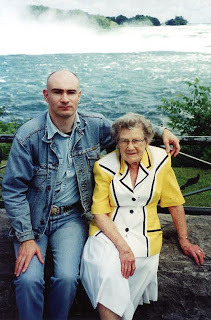 Mom and I at Niagara Falls, Canada, 2000 (Dr Karl Shuker)
Mom and I at Niagara Falls, Canada, 2000 (Dr Karl Shuker)And now, as a pictorial tribute to my mother, here are some more of my favourite photos of her and of us together (click on them to enlarge them), sharing that great adventure called life, with love.
 Mom and the Burj al-Arab Hotel, Dubai, UAE, 2005 (Dr Karl Shuker)
Mom and the Burj al-Arab Hotel, Dubai, UAE, 2005 (Dr Karl Shuker) Mom in our back garden alongside our weeping cherry blossom tree and the water dragon, 2009 (Dr Karl Shuker)
Mom in our back garden alongside our weeping cherry blossom tree and the water dragon, 2009 (Dr Karl Shuker) Mom and I at Pompeii, Italy, 2001 (Dr Karl Shuker)
Mom and I at Pompeii, Italy, 2001 (Dr Karl Shuker) Mom and I at our front door at our previous home, early 1980s (Dr Karl Shuker)
Mom and I at our front door at our previous home, early 1980s (Dr Karl Shuker) Mom at Raffles Hotel, where we stayed when visiting Singapore in 2006, thereby transforming into reality for her another of her lifelong dreams (Dr Karl Shuker)
Mom at Raffles Hotel, where we stayed when visiting Singapore in 2006, thereby transforming into reality for her another of her lifelong dreams (Dr Karl Shuker) Mom in the garden of my Nan (Mom's mother), early 1980s (Dr Karl Shuker)
Mom in the garden of my Nan (Mom's mother), early 1980s (Dr Karl Shuker) Mom and I at the Sydney Opera House, Australia, 2006 (Dr Karl Shuker)
Mom and I at the Sydney Opera House, Australia, 2006 (Dr Karl Shuker) Mom at the Trevi Fountain, Rome, Italy, 2001 – she never did tell me what she wished for when she tossed her coin into the fountain, but I hope that whatever it was, the fountain granted it for her (Dr Karl Shuker)
Mom at the Trevi Fountain, Rome, Italy, 2001 – she never did tell me what she wished for when she tossed her coin into the fountain, but I hope that whatever it was, the fountain granted it for her (Dr Karl Shuker) Mom at the Waldorf-Astoria Hotel where we stayed when visiting New York in 2004 – one wish of hers that I was able to fulfil for her (Dr Karl Shuker)
Mom at the Waldorf-Astoria Hotel where we stayed when visiting New York in 2004 – one wish of hers that I was able to fulfil for her (Dr Karl Shuker) Mom and I with the Little Mermaid statue in Copenhagen, Denmark, 1979 (Dr Karl Shuker)
Mom and I with the Little Mermaid statue in Copenhagen, Denmark, 1979 (Dr Karl Shuker) Mom and a moa statue on a rainy day in Auckland, New Zealand, 2006 (Dr Karl Shuker)
Mom and a moa statue on a rainy day in Auckland, New Zealand, 2006 (Dr Karl Shuker) Mom at Victoria Peak, Hong Kong, 2005 (Dr Karl Shuker)
Mom at Victoria Peak, Hong Kong, 2005 (Dr Karl Shuker) Mom and I with Jonathan Downes, Adam Davies, Keith, and Dave Archer at Weird Weekend 2008 (Dr Karl Shuker)
Mom and I with Jonathan Downes, Adam Davies, Keith, and Dave Archer at Weird Weekend 2008 (Dr Karl Shuker) Mom at Long Lee Manor, Shamwari Private Game Reserve, South Africa, 2008 (Dr Karl Shuker)
Mom at Long Lee Manor, Shamwari Private Game Reserve, South Africa, 2008 (Dr Karl Shuker) Mom on the Copacabana pavewalk, Rio de Janeiro, Brazil, 2007 (Dr Karl Shuker)
Mom on the Copacabana pavewalk, Rio de Janeiro, Brazil, 2007 (Dr Karl Shuker) Mom and I at the Cat Street Gallery, Hong Kong, 2005 (Dr Karl Shuker)
Mom and I at the Cat Street Gallery, Hong Kong, 2005 (Dr Karl Shuker) Mom and a dire wolf at Wookey Hole's Dinosaur Valley, Somerset, 2010 (Dr Karl Shuker)
Mom and a dire wolf at Wookey Hole's Dinosaur Valley, Somerset, 2010 (Dr Karl Shuker) Mom and a Megalosaurus statue at Crystal Palace, London, 2010 (Dr Karl Shuker)
Mom and a Megalosaurus statue at Crystal Palace, London, 2010 (Dr Karl Shuker) In step with each other, as always – Mom and I at Pompeii, Italy, 2001 (Dr Karl Shuker)
In step with each other, as always – Mom and I at Pompeii, Italy, 2001 (Dr Karl Shuker) Mom in her Miami hotel room, Florida, USA, 1981 (Dr Karl Shuker)
Mom in her Miami hotel room, Florida, USA, 1981 (Dr Karl Shuker) Mom and Rudolf, whom we duly rescued after finding him looking very forlorn hidden away on a shelf at a warehouse sale about 10 years ago (Dr Karl Shuker)
Mom and Rudolf, whom we duly rescued after finding him looking very forlorn hidden away on a shelf at a warehouse sale about 10 years ago (Dr Karl Shuker) Mom and I in front of a fallen moai on Easter Island, 2008 (Dr Karl Shuker)
Mom and I in front of a fallen moai on Easter Island, 2008 (Dr Karl Shuker) Mom at the Kennedy Space Center, Florida, USA, 1981 (Dr Karl Shuker)
Mom at the Kennedy Space Center, Florida, USA, 1981 (Dr Karl Shuker) Mom wearing her much-loved Egyptian-themed jacket from Las Vegas (Dr Karl Shuker)
Mom wearing her much-loved Egyptian-themed jacket from Las Vegas (Dr Karl Shuker) Mom and I at Raffles Hotel, Singapore, 2005 (Dr Karl Shuker)
Mom and I at Raffles Hotel, Singapore, 2005 (Dr Karl Shuker) Mom wearing her exquisite protea-decorated jacket from Cape Town, South Africa (Dr Karl Shuker)
Mom wearing her exquisite protea-decorated jacket from Cape Town, South Africa (Dr Karl Shuker) My kind, beautiful, inspirational, and totally amazing mother, Mary Doreen Shuker, aged mid-20s – thank you, Little Mom, for 53 wonderful years of shared happiness, adventures, loyalty, and love (© Mary D. Shuker/Dr Karl Shuker)
My kind, beautiful, inspirational, and totally amazing mother, Mary Doreen Shuker, aged mid-20s – thank you, Little Mom, for 53 wonderful years of shared happiness, adventures, loyalty, and love (© Mary D. Shuker/Dr Karl Shuker)God bless you, Mom. With all my love, always.
Published on April 16, 2013 14:38
Karl Shuker's Blog
- Karl Shuker's profile
- 45 followers
Karl Shuker isn't a Goodreads Author
(yet),
but they
do have a blog,
so here are some recent posts imported from
their feed.



